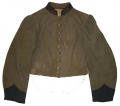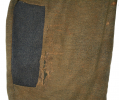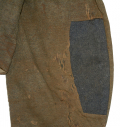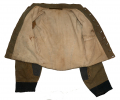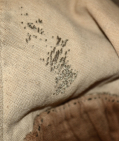site search
online catalog
CONFEDERATE INFANTRY CAPTAIN’S JACKET OF CAPT. NEHEMIAH FOUNTAIN, 10th VIRGINIA, CAPTURED AT GETTYSBURG IN STEUART’S ATTACK ON CULP’S HILL!

$65,000.00 ON HOLD
Quantity Available: 1
Item Code: 1179-507
At Gettysburg the 10th Virginia was heavily engaged in the assaults on Culp’s Hill starting about 7:30 p.m. on the night of July 2 and continued on the morning of July 3 in fighting just as heavy. Posted on the very left of the Confederate advance as part of Steuart’s Brigade, on July 2 they penetrated the Union breastworks, moved up along a stonewall to take Union defenders from behind, driving off the 71st PA and forcing the 137th NY to pull back, repelled a counterattack by two more Union regiments, taking a flag in the process, and then continued the fight in the morning against Union reinforcements, and lastly took part in Steuart’s charge in Pardee Field, with the result that Steuart suffered the highest percentage of loss of any of Johnson’s brigades in the two-day attack, eliciting the cry from Steuart, “My poor boys, my poor boys!” The 10th suffered the loss of 77 officers and men of just 276 engaged- 8 killed, 17 wounded, and 52 captured or missing, including Capt. Fountain, who remained a prisoner of war until 1865.
Once in the collection of Bill Turner, renowned Virginia dealer, collector and author, the jacket was most recently exhibited at the Texas Civil War Museum. It comes with a 2002 letter from Turner, testifying to his purchase of the jacket “over twenty years ago” from fellow Virginia collector Joe Canole, who obtained it from descendants of Confederate Captain Nehemiah Fountain in Stuarts Draft, VA, and also comes with a 2002 letter from Confederate uniform authority Les Jensen, analyzing the jacket’s material and construction, citing comparable examples, and judging it, “a completely original example of a Confederate officer’s jacket.” Not only is it a top-notch example of a Confederate captain’s jacket, it was worn by an officer promoted to that rank on May 3, 1863, at Chancellorsville and captured in action just two months later.
The jacket is sewn completely by hand, single breasted, made of a gray cloth with cotton warp and woolen weft, tabby woven, with a six-piece body closed by nine small Virginia state seal buttons with Horstmann backmarks down the breast. Interestingly, the buttonholes were first put in on the right side of the coat, as in women's garments, but were then sewn up with the buttons are placed over the closed buttonholes and new buttonholes made on the (wearer’s) left lapel. The standing collar is two-piece, dark blue woolen broadcloth on the exterior, with three horizontal strips of gold braid on each side, indicating a Captain. The sleeves are two-piece with non-functional pointed cuffs of the same dark blue material as the collar, with signs they each carried three small buttons. The coat is not padded, and is lined in the body in unbleached cotton osnaburg and has a long, narrow tab for hanging on the base of the collar in the inside. The body lining is very good, showing only minor stains and two small holes near the left lapel. The sleeve linings are fragmentary and made of a thin brown cotton. There are two interior pockets: a slit pocket in the left breast and an added patch pocket of heavier, unbleached cotton, with two brown stripes, (clearly made from something else and showing a buttonhole,) set almost under the armpit on the right side.
The jacket is solid and displays very well. The gray color is very good with just slight fading expected in a real field-worn coat, and the dark blue collar and cuffs are strong. The jacket has expected wear spots, but few holes, with the wear spots blending in pretty well and not very obtrusive. The lower edge and the bottom corner on each lapel shows some old stitches added for reinforcement in two small spots on the right and running up to between the second and third buttonhole on the left. There are some other wear spots on the lower left breast, an area on the bottom right front near the lower edge, a spot under the right arm with one small hole ¼” by ½,” a spot on the upper right sleeve, and wear at top rear of the left shoulder. The left sleeve was patched with gray material on the rear of the elbow, not showing at the front, part way down the rear of the forearm, about 2-1/4” x 6 “with some wear along its rear edge. The dark blue left cuff shows some moth holes. The right arm has a similar patch, just a tad wider and longer, but also not showing from the front, with wear spots above and along it, with a few along the straight edge of the cuff, which also has some moth bites.
Jensen judged the jacket to show excellent workmanship and noted two parallels in officer’s jackets of the 1862 period: one at the Museum of the Confederacy (now the American Civil War Museum) and one at VMI museum, noting they are “clearly a type that saw some service in the Army of Northern Virginia.”
Fountain was born in Denton, MD, in 1832, graduated Dickinson College in Carlisle, PA, in the class of 1854, passed the Maryland bar and opened a practice in Denton. He moved to Woodstock, VA, in the Shenandoah Valley, apparently to open a practice there just prior to the war: he is still in Maryland for the 1860 census, but enlisted at Woodstock on April 18, 1861, in a local company nicknamed the Muhlenburg Rifles, who elected him 2nd Lieutenant. (Anxious to get a taste of life before risking death on the battlefield, married just five days after enlisting, being recorded as an attorney in the documents. The couple eventually had at least three daughters and a son.)
The company joined other Virginia militia units at Harpers Ferry where Jackson was busy organizing troops and were mustered into state service, apparently briefly as Co. K of the 2nd Virginia according to one entry in Fountain’s records, and then as Company F of the 10th Virginia by May 3, assigned to the Confederate States on June 8 and accepted into Confederate service for twelve months on July 1, 1861. He was promoted to 1st Lieutenant of the company on Oct. 8, 1861. Muster rolls list him absent sick on furlough from Dec. 25, 1861, to August 1862, and was then detailed as a Conscript Officer at Woodstock from August 1 through October, according to the Sept-Oct 1862 muster roll. He must have been well regarded by the company, however: on April 3, 1862, they reelected him while still absent as 1st Lieutenant when the company and regiment reorganized for more extended Confederate service. His duty as conscript officer, though close to home, cannot have been entirely pleasant: he later submitted bills for rental of an office, for a room used as a guardhouse, and for ten horses for use by scouts, indicating local residents were somewhat reluctant to be drafted into the army.
He was back with his company by November and present on the rolls thereafter until his capture, with the May-June 1863 roll listing him as promoted to Captain May 3, 1863. Subsequent rolls list him as “missing since Battle of Gettysburg.” A record of prisoners confined at Fort McHenry, MD, lists him as received there July 7 and transferred to Fort Delaware on July 12, and then forward to Johnson’s Island POW camp in Ohio on July 18. He was transferred from there to City Point, VA, on Feb. 24, 1865, for exchange, though whether he was actually exchanged before the war ended is unclear. Events were moving fast, and his file contains no parole or oath of allegiance.
Following the war, he returned to Woodstock, and to the practice of law according to a college biography, but at his death in January 1876 he was listed as an insurance agent.
In addition to Gettysburg, Fountain was in the regiment during its service at First Bull Run and Chancellorsville. At the former engagement they were part of Elzey’s brigade, arrived on the field on July 21 after a rapid march, and were divided with some companies on Bald Hill and some on Henry Hill. Casualties are given as both 5 killed and 11 wounded in the fighting, and 7 killed and 11 wounded. After the battle they were posted Fairfax and then at Centreville. At Chancellorsville they took part in Jackson’s flank march and the fighting on May 2 and May 3, losing 157 officers and men, including their Colonel wounded and Lt. Colonel and Major killed. Fountain’s promotion to Captain, dated May 3, certainly reflects a necessary reshuffling to fill vacancies. His promotion to Captain at that point also gives him that rank in the Second Battle of Winchester, June 13-15, when Ewell, leading Lee’s advance, defeated Milroy’s garrison holding the town, and with it captured a large stockpile of supplies, some 4,000 prisoners, and opened up the Shenandoah for Lee’s push north. It was fitting, given Fountain’s Maryland origin, that in the campaign his regiment served under Gen. Steuart, a Marylander, whose brigade included the 1st Maryland Battalion.
This is an extraordinary piece, with great provenance, and wonderful Gettysburg connections. Other photos, copies of the Jensen letter, etc. are available to interested parties. [sr][ph:L]
~~~~~~~~~~~~~~~~~~~~~~~~~~~~~~~~~~~
THIS ITEM, AS WITH ALL OTHER ITEMS AVAILABLE ON OUR WEB SITE,
MAY BE PURCHASED THROUGH OUR LAYAWAY PROGRAM.
CLICK HERE FOR OUR POLICIES AND TERMS.
THANK YOU!
Inquire About CONFEDERATE INFANTRY CAPTAIN’S JACKET OF CAPT. NEHEMIAH FOUNTAIN, 10th VIRGINIA, CAPTURED AT GETTYSBURG IN STEUART’S ATTACK ON CULP’S HILL!
For inquiries, please email us at [email protected]
Most Popular
Historical Firearms Stolen From The National Civil War Museum In Harrisburg, Pa »
Theft From Gravesite Of Gen. John Reynolds »
Selection Of Unframed Prints By Don Troiani »
Fine Condition Brass Infantry Bugle Insignia »
Wonderful Condition Original Confederate-Manufactured Kepi For A Drummer Boy Or Child »
featured item
TWO PEN AND INK DRAWINGS BY ALFRED WAUD / HORATIO WAIT OF BLOCKADING SCENES OFF MOBILE 1863
Working as a special artist for Harpers Weekly from late 1861 through 1865, Alfred R. Waud (1828-1891) is one of the best-known Civil War artists. In postwar years he was connected with Century Magazine, which published numerous accounts of the Civil… (557-12). Learn More »
site search
Upcoming Events
The shop will remain closed to the public through Friday, Jan. 24th, re-opening on Saturday, Jan.… Learn More »



